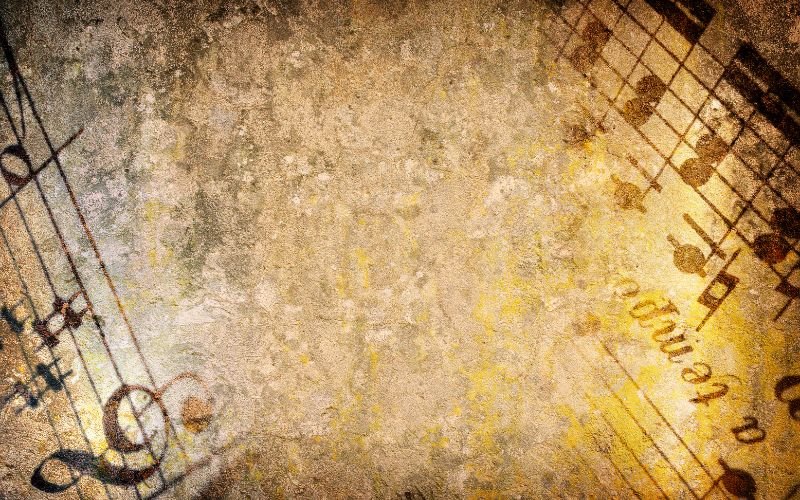The evolution of music through the ages, from its origins to modern times
Imagine a world without music: no melodies to brighten our days, no rhythms to accompany our steps, no songs to capture our emotions. Impossible, isn't it? Music tells our story, expresses our emotions and unites people. From the mystical resonance of ancient drums to the electric chords of modern guitars, music has gone through many evolutions.
Whether you're a classical fan, a jazz enthusiast or a rock fan, discover how music has reinvented itself over the years.
The origins of music, from prehistoric rituals to ancient civilizations
The first notes of music date back to time immemorial, long before writing. Simple songs and rhythms, created with stones and sticks, formed the basis of prehistoric music. Archaeological finds have revealed bone flutes and percussion instruments dating back millennia. Used for religious rituals, hunting and celebrations, this music served to reinforce group cohesion.
In ancient times, with the emergence of the first great civilizations, music became more structured and complex. In Egypt, music was part of religious rites and festivals, with instruments such as the harp, lute, tambourine and flute. Hieroglyphics and wall frescoes testify to the importance of music in daily and ceremonial life. In ancient Greece, music, poetry and dance were closely linked.
Ancient Rome, influenced by Greece, integrated music into its cultural and religious practices, using similar instruments and developing musical performances for games and banquets.
The Middle Ages, from liturgy to ancestral melodies
From the 5th to the 15th century, the Middle Ages saw a flowering of music in the West. Liturgical music dominated with Gregorian chant, a simple, melodic, monodic form of chant intended for religious services. At the same time, secular music emerged with the troubadours and trouvères (poets and composers), who composed songs about courtly love and chivalry, spreading musical culture throughout the seigneurial courts.
The Middle Ages saw a diversification of instruments. Organs became more complex, viols and lutes gained in popularity, and flutes, chalumeaux and bagpipes were commonly used. A key innovation is polyphony, where several voices sing harmonious melodies simultaneously, marking a major turning point with composers like Léonin and Pérotin at the École de Notre-Dame de Paris. This rich and varied period laid the foundations for the musical developments of the Renaissance, illustrating theingenuity and diversity of medieval musical practices.
The Renaissance, the golden age of polyphonic music
The Renaissance, from the 15th to the early 17th century, was a period of artistic renewal in Europe. Marked by a return to classical ideas, this period emphasized humanism, expressivity and harmony in music. Polyphony reached new heights of complexity and beauty with composers such as Josquin des Prez, Palestrina and Orlando di Lasso. Masses, motets and madrigals became major forms, characterized by clarity, balance and refined use of counterpoint.
The Renaissance also saw a significant evolution in instruments and their use. The harpsichord and organ gained in popularity, while the lute became emblematic for accompanying voices and solo playing. Instrumental ensembles diversified with viol consorts and other instruments such as the recorder, cornet and sackbut. At the same time, music notation continued to develop, enabling more accurate and reliable transmission of musical works. Music printers, such as Petrucci's in Venice, distributed scores widely, facilitating the circulation of works throughout Europe.
Innovative musical forms, such as the Italian madrigal, French chansons, German lieder and Spanish villancicos, bear witness to the vocal richness of this era. The Renaissance was a golden age for music, characterized by a quest for beauty and expression, laying the foundations for Baroque music to come.
The Baroque era: musical grandiosity and innovation
The Baroque period (1600-1750) is characterized by a grand, dramatic artistic and musical style. Baroque music is marked by dynamic contrasts, intense emotional expressiveness and elaborate ornamentation. This period of cultural and social transformation saw the rise of absolute monarchies and the development of new forms of artistic expression, including opera. With Claudio Monteverdi's "L'Orfeo", opera was born and became central to European musical culture. The use of the basso continuo, a continuous bass line supporting the harmony, is also a key feature of this period. The Baroque period also saw the development of chamber music, cantatas and dance suites.
📌 Famous composers of the Baroque period
Johann Sebastian Bach left his mark on almost every musical genre of his time. His "Brandenburg Concertos", "Cello Suites" and "Cantatas" demonstrate his talent for complexity. He is also known for keyboard works such as "The Well-Tempered Clavier" and "The Art of Fugue".
George Frideric Handel left his mark on Baroque music with his operas, oratorios and concertos. His oratorio "Messiah", with the famous "Hallelujah" chorus, is emblematic of the period. Handel fused Italian, German and English influences to create a rich, dramatic style.
Antonio Vivaldinicknamed the "Red Priest", is best known for his concertos, notably "The Four Seasons", famous for their virtuosity and ability to evoke images and emotions.
Classicism, pure elegance in simplicity and harmony
The Classical period (1750-1820) was characterized by a return to simplicity, elegance and balance, in contrast to the exuberance of the Baroque. Inspired by the ideals of the Enlightenment, composers sought clarity and formalism. The sonata form, structured in several contrasting movements, became central, influencing symphonies, string quartets and sonatas. Works from this period are marked by clear melodies, simple but effective harmonies and homophonic textures.
📌 Influential composers of the classical period :
Joseph Haydn, nicknamed the "father of the symphony" and the "string quartet", was a mentor to Beethoven and a friend of Mozart, and contributed to the development of the music of the time.
Wolfgang Amadeus MozartWolfgang Amadeus Mozart, a musical prodigy, composed famous and beloved works such as the operas "Don Giovanni", "The Marriage of Figaro" and "The Magic Flute". Mozart also excelled in symphonies, concertos and sonatas, displaying virtuosity and sensitivity.
Ludwig van Beethoven marked the transition between Classicism and Romanticism. His early works are classical, but he developed a personal, expressive style. His nine symphonies, notably the Fifth and Ninth, combine dramatic power with emotional depth. Beethoven also innovated in string quartets, piano sonatas and concertos.
The classical period popularized the symphony, a central orchestral form in public concerts. The symphonies of Haydn, Mozart and Beethoven defined and set the standards for the genre. Chamber music, especially the string quartet, flourishes. The quartets of Haydn, Mozart and Beethoven explore the intimate interaction between instruments, creating works rich in harmonies and contrapuntal complexity.
Romanticism, passion and individuality
The Romantic period (1820-1900) is characterized by emotional intensity and marked individuality. In reaction to classical rigor, Romantic composers expressed personal feelings and explored dramatic and fantastical themes. Their music is rich in dynamic contrasts, lush orchestral textures and bold harmonies, often inspired by literature, nature, history and legend. Musical forms become more flexible, allowing greater freedom of expression, especially in symphonies, operas, lieder and symphonic poems.
📌 Key composers of the Romantic period :
Franz Schubert, a pioneer of Romanticism, is famous for his Lieder, capturing a vast scale of emotions. His lieder cycles, such as "Winterreise" and "Die schöne Müllerin", are masterpieces of melody and piano accompaniment. He also composed symphonies and chamber music that bear witness to his melodic genius.
Piano virtuoso Frédéric Chopin revolutionized music for the instrument with his nocturnes, mazurkas, polonaises and preludes, showcasing the lyrical beauty and technical complexity of the piano.
Richard Wagner transformed opera with his grandiose conceptions and musical innovations, such as leitmotifs and rich orchestration. Works such as "Tristan und Isolde" and "The Ring of the Nibelung" are emblematic of this era.
Giuseppe Verdi, a giant of romantic opera, created works famous for their memorable melodies, such as "La Traviata", "Rigoletto" and "Aida".
Johannes Brahms integrated classical traditions into a Romantic context. His symphonies, concertos and chamber music are renowned for their harmonic richness and emotional depth. Brahms also composed magnificent choral works such as the "German Requiem".
The Romantic period also saw the emergence of symphonic poems, orchestral works inspired by poems and stories by composers such as Franz Liszt and Richard Strauss.
Romantic musical forms become longer and more complex. The symphony expanded in length and structure, sometimes incorporating choruses and dramatic elements. Concertos showcase individual virtuosity while exploring dialogues between soloist and orchestra.
Lieder and lieder cycles allow composers to set poems to music and explore intimate, personal themes. Chamber music continues to develop, offering complex and emotional musical interactions between instruments.
Modernity and audacity, music from the 20th century to today
The 20th century was marked by great diversity and daring innovation. Composers challenged established traditions and explored new sounds, techniques and musical forms. Atonality, developed by Arnold Schoenberg and his students, rejects the traditional tonality , creating works in which all notes are of equal importance. Schoenberg also introduced the dodecaphonic, or serial, technique.
Neoclassicism, with figures like Igor Stravinsky, returns to forms and styles of the past, but with a modern approach. Electronic music, with pioneers like Karlheinz Stockhausen and Pierre Boulez, uses synthesizers and computers to create new sounds.
Several distinct trends are emerging:
Impressionism: initiated by Claude Debussy and Maurice Ravel, with floating harmonies and delicate timbres, exemplified by works such as "Prélude à l'après-midi d'un faune" and "Boléro".
Expressionism: characterized by intense emotions and atonal techniques, exemplified by Alban Berg's opera "Wozzeck".
Minimalism: represented by Steve Reich, Philip Glass and Terry Riley, focuses on the repetition and slow gradation of musical motifs, influencing contemporary music and cinema.
📌 Composers who left their mark on twentieth-century music :
Igor Stravinsky revolutionized music with works like "The Rite of Spring".
Béla Bartók incorporates Hungarian folk music into his compositions.
John Cage pushes the boundaries of music with avant-garde works such as "4'33"".
Leonard Bernstein bridges the gap between classical and popular music with "West Side Story".
The 20th century saw a growing fusion of musical genres. Composers like George Gershwin incorporated elements of jazz into symphonic music with "Rhapsody in Blue". Groups like The Beatles incorporated classical music techniques and instruments from around the world into their music.
Contemporary music incorporates influences from all cultures. Composers Tan Dun and Osvaldo Golijov, for example, fuse elements of Asian and Latin American music with Western forms.
The twentieth century represents a period of creativity and innovation unprecedented in the history of music. Today, music continues to evolve, enriched by the innovations of the past and open to the infinite possibilities of the future.
💡 With Newzik, immerse yourself in every musical era with ease. Annotate, edit and organize your digital music scores in the blink of an eye. Whether you're a fan of medieval polyphony or a devotee of 20th-century innovations, Newzik accompanies you every step of the way on your musical journey. Revolutionize your rehearsals and performances with the Newzik application.

